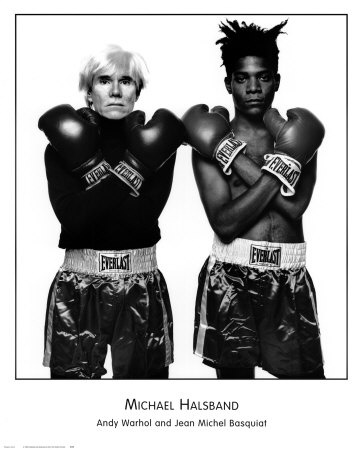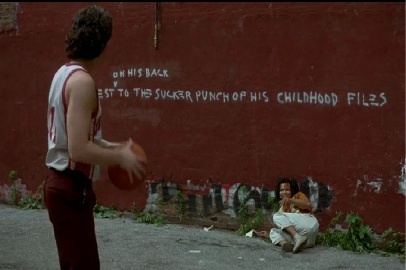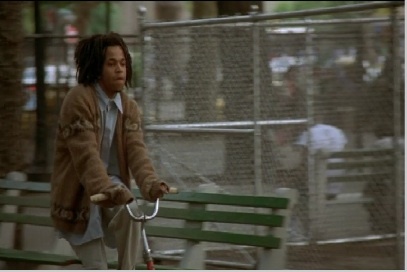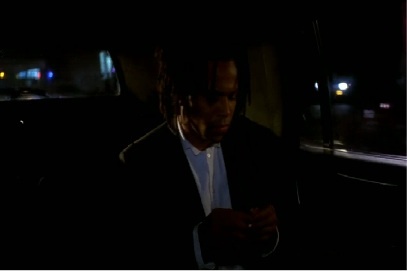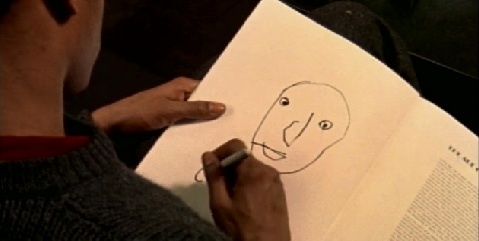DAY 1: Today is Tuesday January 3rd - An INTRODUCTIONS AND IDEAS day. Scroll down the page to view clips from two films that direct our attention to the art
market through the real life example of artist and art market entrepreneur, Jean Michel Basquiat (1960-1988). The first film, Basquiat (Julian Schnabel, dir. 1996)
is a fiction film about the artist's life starring Jeffry Wright as Basquiat, Benecio del Toro as the artist's friend and David Bowie as Andy Warhol. The second film,
Downtown 81 stars Basquiat as himself. The selected clips highlight different aspects of the art market, including how artist's market themselves, how they
'become famous,' the relationship between artists, dealers and galleries, and so on. Take note of these and other aspects you glean from these clips to write
your own definition of the art market in 250 words or less in the space next to your name provided below. Comment on each other's definition in the comment box.
On the last day of class, you will be asked to rewrite your definition of the art market based on what you have learned in this class.
Basquiat
Fame, Integrity And the Beating machine
A Primal Impressionist
Philosophy and Caviar With Warhol
Chapters 14 to 15
Friends
Notoriety
Downtown 81
Rent
Individual Contributions
| Panel |
|---|
Christina Chaplin It seems to me as if the art market should be defined as the space in which art is traded for currency, whether that currency is money, art, or power. The art market is thus ultimately made up of people interacting with other people, and like any human effort is wrought full of ego, manipulation, subjectivity, and reaction. Similar to any economic system for trading goods, it seems as if the value of the art work is set arbitrarily at first and adjusted based on levels of supply and demand. Basquiat sets his painting price at $500 for Mrs. Cavalcanti simply because that is how much he needs at the time. However, in another clip we see him tell a friend that a gallery is offering $5,000 for a sketch previously worth $2. The demand for his work has increased and thus so can the price. Yet the relationship to demand seems more complicated. The demand increases with fame, which seems to itself derive from a friendship that forms between a young artist and an established one. Association with fame can bring intrigue and then fame can follow if the interest is suspended. One artist is able to market himself by drawing attention to his work and gaining the respect of other artists and dealers. But as Basquiat's friend mentions, one must then adhere to a certain set of parameters within one's own work in order to suspend the interest and not confuse or anger their audience. Only by forming relationships with dealers and galleries, being respected by peers/buyers, and maintaining a certain amount of public appeal can one keep demand for the work high enough to bring in a good price for the art work. Therefore, only by playing to the human side of the market can one find economic success. |
| Panel |
|---|
Dalanda Jalloh Assignment 1: The art market can be described as the arena in which artists, buyers, sellers, and the art-interested community, interact with one another. The artist is the central branch in this tree of connections with the other branches consisting of the buyers, sellers, and the artist’s community. In the art market, the artist’s life seems to be marked by a constant struggle and need for self-preservation_._ Initially, the artist struggles to develop a name for his or herself. He or she must define who they are, what type of art they are known for, and then must promote their brand to the community. This can be self-promotion and/or the promotion from the media, which the artist must ensure, will attract his or her desired audience. This media portrayal, if negative, acts as another point of struggle in the artist’s life. The drive for self-preservation forces the artist to connect his or herself with famous people in the art market, as a means of earning money and creating the opportunity to interact with more people who can help satisfy his or her need to survive. Through these interactions in the art market, the artist survives. He or she earns a living such that they are housed, fed, and have the ability to make more art so the artist can repeat this cycle. The cycle seems to continue until the artist has had enough of his or her art, or ends if the art-interested community has had enough of the artist. |
| Panel |
|---|
Charles Saunders From my limited prior knowledge and from information gleaned in the above clips, the art market appears to be a relatively disjointed market with a lack of central, streamlined processes in which buyers and sellers interact. Instead, the market seems to be composed of art producers who rely primarily on personal relationships, bargaining and self-promotion, and a dependence on the subjective and changing tastes of the art buyers. In fact, it seems that supply grossly outweighs demand, as buyers compete over a select few artists who have gained recognition, setting disproportionately high prices in the process, while the majority of new artists are forced to use their paintings as a form of currency in maintaining their livelihood while they struggle to achieve recognition. One of the most significant characteristics that defines the art market is the fact that, in many cases, these works of art serve as a form of currency for the artists, but their value nevertheless remains purely subjective. Since there is little intrinsic value in any given work of art, its value becomes defined by current tastes and buyer’s preferences, which may be hard to predict and match. A given artist might find himself recognized for filling an artistic niche, from which he might never escape, as the large supply of artists imply that switching styles is difficult once an artist is recognized. In summary, my perception is that in the art market, artists are price-takers, subject to unpredictable fluctuations in demand, with substantial variation in price. |
| Panel |
|---|
Lipei Yu |
| Panel |
|---|
H Hunt Bradley III In these scenes, I’m most interested in how the art market is contingent upon the narrative both of Basquiat and his art. In the first scene we see Basquiat, out of the desire to “make it,” create a market with Warhol that codifies his art as a means of survival. Basquiat’s reward, within the first transaction, is far beyond the ten dollars, he uses money as a vehicle to begin a dialogue and elicit a critique. I find this interesting when we juxtapose this against him buying marijuana, smoking it and seamlessly walking down the street, a transaction that is an end to itself. Another example is the caviar scene, where the transaction actually works to stifle narrative, dialogue and critique. Then, unsuccessfully able to locate his art within a narrative, Basquiat, is unable to use his painting as a substitute for rent. In the last scene, we see a highly sexual critique that conflates the strong (healing) and savage (fighting for survival) artist and his art, and he is rewarded with $500 in compensation, for both his art and the chance to see him again. There are many factors in play in all of these transactions. What I feel is interesting is that the lasting monetary value of his art lies in the ability of Basquiat, to create a narrative and dialogue that endures beyond the transaction. This, to me, is the lifeblood of the art market. |
| Panel |
|---|
Daniel Chazen Assignment #1. Money, power, and people using each other to get what they want are the first words that come to mind in defining the art market. Artists know that their work can have value and that there are customers willing to pay for it. The money is as important to the artist as it is to the customer; it is what fuels the relationship between the two. For example, while Mrs. Cavalcanti in the Downtown 81 film may have a physical attraction to Basquiat, the money is what moves their relationship. As much as Basquiat may be a talented artist and as much as Mrs. Cavalcanti may be seducing him and interested in his work, the money is the key to the art market transaction in which they engage on the couch in her apartment. And I think they both know that money is essential to the deal, but go through their encounter without talking much about it as that would kind of detract from him being an artist and her status as a rich person. Power is probably as important as money in defining the art market. The artists have the goods that are in demand. And they can use their product, which gives them power, to secure what they want. As depicted in the film Basquiat, an artist can use his art to “trade.” Warhol tells Basquiat he should not be giving “away” his work. Warhol’s relationship with Basquiat is a good example of how power defines the art market. Warhol befriends Basquiat for his artistic ability, while Basquiat seems to befriend Warhol for his fame. They each use their own power to get more power. |
| Panel |
|---|
Kwame Nana-Atoo Assignment 1 To most people the art market is the selling and buying of artworks., but what comes in mind is the process of getting there- the hows, where, and when to make the connections, reactions, communications and interactions when you meet people and when to know when the time is right to act i.e. if there is even such a thing as the right time or its just chance. Interesting enough, most art schools have turned a blind eye on informing art students about what happens in the art market, making it almost seem like a taboo to talk about. From the videos my first impression about the art market was being patient, continual working, and having a unique but consistent style so that your work will be easily recognizable by other artists and art collectors/buyers. Also it is very important to be prepared to accept the many critiques that are written about you when you start becoming recognized; good and the bad. Always be prepared to have something to sell and when you sell, sell big. I think that as emerging artist we are always confronted with how much to sell our works- and we worry that people will not buy when its high, but I learnt something very critical in the videos“it is not how much you work on something that matters, its how much you get for them”… Art market for you. |
| Panel |
|---|
June Shin Although the entire scope and the many facets of the art market probably cannot be apprehended at this point with the little knowledge I have, the video clips about Basquiat and his rise to fame reveals something about the art market. It seems to be true that, in the art market, how much an artist get for his work is more important than how much of it is by his or her own hands. For example, Andy Warhol is not always the sole producer of his work (he takes from others, whether it be the subject matter, labor, etc.), yet he is endorsed as one of the greatest modern artists. This example also highlights marketing (and self-advertisement as part of it) as a critical operation in acquiring fame. In the first video clip, Basquiat’s friend tells Basquiat the legend of John Henry. I think that John Henry stands as a metaphor to those artists who fail to recognize the market’s role in today’s art world and adapt to it by employing the necessary strategies will eventually fade. An artist can only be financially successful when he is acknowledge and respected by the right people. For instance, Basquiat’s landlord cannot fathom that the painting would sell for $500. To one person a work of art can be no more than a junk while to another it can be worth however much monetary value he/she attaches to it if necessary circumstances are met. |
| Panel |
|---|
McKenzie Sullivan Assignment 1 In my opinion the term “art market” refers to the combination of price, policies, politics, the quality of artistic endeavor as well as the power of marketing that influence the trade of artworks around the world; whether they be paintings, drawings, works on paper, sculpture, photography or graphic prints. The art market revolves heavily around the supply and demand of works over time. Marketing hype by dealers and pre-sale estimates set by auction houses aid in defining the pricing structure art transactions. When the demand grows for the work of a particular artist, because of limited supply or clever marketing, the price of an artwork can be greatly increased. Marketing power plays an important factor in such transactions. An artist, like Basquiat has a steady supply of goods that have grown in demand thanks to dealer marketing over time as well as his notorious relationship and collaboration with the famed Andy Warhol. Basquiat built his own success on Warhol's fame. As depicted in the film, Basquiat initially uses his art to trade with. Warhol tells Basquiat he should not be giving away his work. Through Warhol’s relationship gradually Basquiat succeeds in better marketing his works through dealers and galleries. His story is a good example of how marketing power also defines the art market. Warhol befriends and endorses Basquiat for his unique artistic ability, while Basquiat seems to befriend Warhol for his fame. They each begin to use their own influence to enhance the other’s power. |
| Panel |
|---|
Elena Cestero The art market is the exchange of art through its buying, selling, or trading, the value of which is determined by the intersection of multiple factors and influences such as self-promotion, visibility, development of a recognizable style, social connections, patron taste/interest, and competition. Out of necessity and desperation the artist must self promote (Basquiat’s public graffiti), make significant social connections (Basquiat approaching Warhol in a restaurant), and learn to flatter patrons to their advantage (Basquiat and Mrs. Cavalcanti). It is also understood that the work of the successful artist to some extent caters to the tastes of the patrons who have the ability to supply the artist with the prestige, wealth, and wide-ranging visibility that they desire. The patrons, dealers, and galleries view the artist and their art as an investment and will attempt to manipulate and monopolize the work for the greatest profit. The artist must in turn manipulate the patron, dealer, or gallery with the praise and promises of exclusivity that will most profit the artist. The art market, in summation, is a system of mutual exploitation. |
| Panel |
|---|
Jacqueline Park |
| Panel |
|---|
Tadd Phillips The art market is the buying, selling, and trading of works of art. It differs from markets for most commodities in some fundamental ways. Perhaps most importantly, there is an incredible amount of uncertainty in the value of what is being sold. This uncertainty was referred to several times in the movie clips. When Basquiat sells a painting to Mrs. Cavalcanti, his asking price is determined by what he happens to need in order to pay his rent. A drawing on a scrap of paper that he sold for $2 was valued at $5000 only a week later. Some of Warhol’s works have shown even wilder fluctuations. One painting that sold for $1000 in 1962 later sold for $15 million in 1996; see [this article|http://www.economist.com/node/14941229] for similar examples. As an artist’s reputation grows, he or she can ask for higher prices. When Basquiat meets Warhol in the first clip, Warhol doesn’t even want to pay $10 for one of Basquiat’s drawings. Soon, as Basquiat becomes known, someone buys one of his scraps of paper for $5000. |
| Panel |
|---|
| Panel |
|---|
| Panel |
|---|
Kelly Zona It seems that the art market is a relationship of social and economic factors centered around the idea of “creating value” for both artists and their works. In the first clip, Basquiat tries to sell his paintings to Warhol for the arbitrary price of ten dollars a piece, and although he insists on nothing less, he leaves the unbought paintings behind. Did it matter if Warhol paid a higher price or if he was given all of them for free? It seems more important that Basquiat was able to get recognition from Warhol, thereby adding a new layer of value to his works and his name. The role of social forces in creating value is brought up again when Basquiat complains to Warhol that media is creating a negative portrayal of him, and Warhol responds, “No Jean, that's good. At least they're interested,” emphasizing that even controversy can boost artistic value. Another concept brought up in the videos is branding, which plays a huge role in creating value. As Basquiat's friend points out, one must keep “the same style.” In other words, one must establish a brand, or common threads throughout their work, in order to secure their relationship with galleries, dealers, and their audience. A simple drawing that Basquiat exchanges for a pack of cigarettes is later bid on for $5,000 because his name is gaining recognition. Warhol reinforces the idea stating that, “It's not how much you work on something that matters, its how much you get for it.” It is more difficult to assign value to a piece of art based on subjective criteria such as amount of work, style, subject...etc. But certain factors are easier to assign value to, such as a well known name. |
| Panel |
|---|
Nicholas Krislov The Art Market is a means of trading an Artist's work in both the primary and secondary markets for money or goods based on the perceived value of the pieces' demand and societal preferences. The Art Market refers to more than just the buying and selling of art. The price and value of the art to each person are not indicative of the market as a whole because unlike other businesses, the quality of the artwork is difficult to judge, and could mean many things to many people. Instead it is a mix many factors which determine the price of the art including inspiring feeling from artists and buyers, giving different prices based on individuals' emotions, perceived demand and ultimately the willingness of buyers to pay for the right to enjoy these feelings derived from the art. The portions of the clips I found most interesting are the aspects of how to become famous and granting other's access to your talent. In the first clip, Basquiat first asks how, and how long does it take to become famous- as if there is a readily available answer. At points, it is not the true skill of the artist which begs social attention, but the fact that others are also giving the attention. Basquiat sells one piece to pay for a pack of cigarettes, but it is resold on the secondary market for $5,000. It is the perceived value by the secondary market, not the supply or demand, as Basquiat would have certainly sold it for more. In contrast to spending large amounts on a piece in the secondary market, Warhol suggests going to Pittsburgh to see replicas of famous statues. The there is an extreme difference between going to see an exhibit of replicas and buying expensive modern art- however Warhol enjoys the emotional value of the art he sees, not the status of owning a piece. |
| Panel |
|---|
| Panel |
|---|
Khrystyne Wilson Version:1.0 StartHTML:0000000194 EndHTML:0000003655 StartFragment:0000002386 EndFragment:0000003619 SourceURL:[file://localhost/Users/khrystynewilson/Documents/Winter%20Course%201-3-12.doc|file://localhost/Users/khrystynewilson/Documents/Winter%20Course%201-3-12.doc] I do not know much about art, as an outsider the Art Market seems to literally, be a place to buy and sell art, however it is clear that there are different levels of the market, and many implications about the art to determine whether it is quality or not. It also seems as though there is a difference between those on the inside of the art market and those on the outside, and the threshold between the two is not entirely flexible. One cannot enter the art market without a basic understanding of not only the artwork itself, but also its implications and how it is or will be received in society. Thus, there is no standard for how much one piece of art is worth monetarily, but rather it is a combination of the art, the artists’ level of fame, and society’s demand for the artwork. This can be seen through the clips of the film about Basquiat, how depending on the demand for his artwork, the same piece can increase in price from $2 to $5000. Overall the art market seems as though it is not entirely fair, nor is it entirely cohesive. The worth of art seems to be capriciously applied to each individual piece based, not on the work itself, but rather on society’s reception of the artist. |
| Panel |
|---|
| Panel |
|---|
Consider & comment:
Please use this space to respond to your classmates' work and to engage in lively discussions on the day's topic. Keep your comments concise and conversational by responding to others, rebutting or supporting their ideas. Use the comment box below for these observations.
